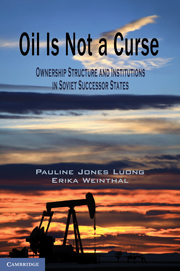Book contents
- Frontmatter
- Contents
- Tables
- Figures
- Maps
- 1 Rethinking the Resource Curse
- 2 Why Fiscal Regimes
- 3 State Ownership with Control versus Private Domestic Ownership
- 4 Two Versions of Rentierism
- 5 Petroleum Rents without Rentierism
- 6 State Ownership without Control versus Private Foreign Ownership
- 7 Eluding the Obsolescing Bargain
- 8 Revisiting the Obsolescing Bargain
- 9 Taking Domestic Politics Seriously
- 10 The Myth of the Resource Curse
- Appendix A List of Authors’ Interviews
- Appendix B Variation in Ownership Structure in Developing Countries
- Appendix C Responses to Select Life in Transition Survey (LiTS) Questions by Age Group
- Appendix D Ranking Basis for Determining which Countries are Included in Our Database
- Works Cited
- Index
4 - Two Versions of Rentierism
State Ownership with Control in Turkmenistan and Uzbekistan
Published online by Cambridge University Press: 05 June 2012
- Frontmatter
- Contents
- Tables
- Figures
- Maps
- 1 Rethinking the Resource Curse
- 2 Why Fiscal Regimes
- 3 State Ownership with Control versus Private Domestic Ownership
- 4 Two Versions of Rentierism
- 5 Petroleum Rents without Rentierism
- 6 State Ownership without Control versus Private Foreign Ownership
- 7 Eluding the Obsolescing Bargain
- 8 Revisiting the Obsolescing Bargain
- 9 Taking Domestic Politics Seriously
- 10 The Myth of the Resource Curse
- Appendix A List of Authors’ Interviews
- Appendix B Variation in Ownership Structure in Developing Countries
- Appendix C Responses to Select Life in Transition Survey (LiTS) Questions by Age Group
- Appendix D Ranking Basis for Determining which Countries are Included in Our Database
- Works Cited
- Index
Summary
I’m becoming more and more convinced in the correctness of my decision to provide the population with such an inordinate degree of social protection, as its implementation has allowed every Turkmen to receive practically every day a guaranteed share of our national wealth, every hour to feel the support of the state. …
– Saparmurat Niyazov, President of Turkmenistan, explaining his decision to give free gas, electricity, and water to the populationUntil recently, we were forced to import virtually all important oil products, mainly from Russia. But a lot has been done towards achieving energy self-sufficiency in the last two or three years … . [Now we can reduce the amount of] cotton we sell to buy these products. We will sell cotton instead to satisfy people’s needs; we will buy foodstuffs and consumer goods, build new factories and facilities.
– Islam Karimov, President of Uzbekistan, September 1994Turkmenistan and Uzbekistan stand alone among the petroleum-rich Soviet successor states in their decision to retain the ownership structure that they inherited from the Soviet Union – that is, state ownership with control (S1), and thus to eschew direct foreign involvement. By 1992 – just one year after declaring their independence – the newly elected presidents of both countries had publicly asserted that both petroleum resources and the right to develop them belonged solely to the state and began restructuring their respective oil and gas industries to reflect the “transfer” of property from the Soviet state to their own nations. Alongside newly empowered oil and gas ministries, therefore, emerged fully state-owned concerns or corporations, such as Turkmengaz, Turkmenneft, and Uzbekneftegaz, to perform the oversight and managerial functions previously usurped by the Soviet government (for details, see IEA 1998). “These new national concerns,” according to von Hirschhausen and Engerer (1998, 1116), “simply inherited almost the entire exploration, production, transmission and some distribution activities, engineering and other elements of their respective republics, not to forget all ‘social assets.’”
For those who emphasized institutional continuity with the Soviet system, S1 may seem the most obvious choice. Indeed, neither country had a significant petroleum industry prior to Soviet rule. Although oil extraction began in both Turkmenistan and Uzbekistan prior to the Bolshevik Revolution, it was rather minimal and mined primarily for kerosene, which was then used in the cotton-processing factories and dairies (Sagers 1994). Yet, considering their mutual need for significant capital investment to build new and upgrade existing infrastructure, the decision to go it alone is not only surprising, it is quite counterintuitive (see Amuzegar 1998). Nor, as others have claimed, was S1 the only choice due to the sheer dearth of interested foreign investors and – particularly in the case of Uzbekistan – the meagerness of estimated reserves. On the contrary, several foreign oil and gas companies were clamoring to buy into both countries’ petroleum sectors immediately after the Soviet Union’s demise. Enron’s representative in Uzbekistan, who arrived in 1994, for example, underscored that this was “the only time that Enron has come into a country without a deal signed first,” justifying this decision with the conviction that “more than half of the country contain[ed] undiscovered and untapped oil and gas reserves” (Authors’ interview). Moreover, although Uzbekistan did not have the same level of proven reserves as either of its Central Asian counterparts, the potential rents from its petroleum sector were believed to be “still higher than Indonesian oil rents during the 1974–78 and 1979–81 oil booms” (Auty 2003, 259). Furthermore, although Uzbekistan’s total potential rents as a percentage of its GDP were about half of both Azerbaijan’s and Turkmenistan’s in 2000, they certainly rivaled Kazakhstan’s (see Table 4.1).
- Type
- Chapter
- Information
- Oil Is Not a CurseOwnership Structure and Institutions in Soviet Successor States, pp. 77 - 120Publisher: Cambridge University PressPrint publication year: 2010



